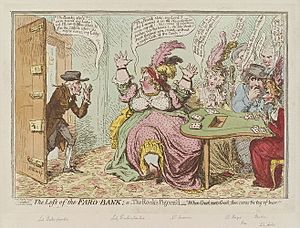James Gillray facts for kids
Quick facts for kids
James Gillray
|
|
|---|---|

James Gillray
|
|
| Born | 13 August 1756 or 1757 Chelsea, London, England, United Kingdom
|
| Died | 1 June 1815 (aged 57 or 58) London, England, United Kingdom
|
| Nationality | English |
| Occupation | Caricaturist, printmaker |
James Gillray (13 August 1756 or 1757 – 1 June 1815) was a British caricaturist and printmaker famous for his etched political and social satires, mainly published between 1792 and 1810.
Gillray has been called "the father of the political cartoon", with his works targeted at George III, prime ministers and generals. Regarded as being one of the most influential cartoonists, Gillray's wit and humour, knowledge of life, keen sense of the humorous, gave him the first place among caricaturists.
Contents
Biography
He was born in Chelsea, London. His father had served as a soldier: he lost an arm at the Battle of Fontenoy and was admitted, first as an inmate and subsequently as an outdoor pensioner, at Chelsea Hospital. Gillray commenced life by learning letter-engraving, at which he soon became adept. Finding this employment irksome, he then wandered for a time with a company of strolling players. After a chequered experience, he returned to London and was admitted as a student in the Royal Academy, supporting himself by engraving, and probably issuing a considerable number of caricatures under fictitious names.
Gillray's caricatures are generally divided into two classes, the political series and the social. They were circulated not only in Britain but also throughout Europe, and exerted a powerful influence both in Britain and abroad.
During the French Revolution, Gillray took a conservative stance, and he issued caricature after caricature ridiculing the French and Napoleon (usually using Jacobin) and glorifying John Bull. A number of these were published in the Anti-Jacobin Review. A number of his most trenchant satires are directed against George III.
Gillray's eyesight began to fail in 1806. He produced his last print in September 1809.
His last work, from a design by Bunbury, is entitled Interior of a Barber's Shop in Assize Time, and is dated 1811. While he was engaged on it he became mad, although he had occasional intervals of sanity, which he employed on his last work. The approach of madness may have been hastened by his intemperate habits.
Gillray lapsed into insanity and was looked after by Hannah Humphrey until his death on 1 June 1815 in London; he was buried in St James's churchyard, Piccadilly.
Collecting
Auction prices for Gillray's work have increased since the 1970s. At the auction of the Draper Hill Collection at Phillips auctioneers in London in 2001, several key prints sold for more than US$10,000. Since 2002, annual auctions of Caricatures at Bonhams in London, each of which included large selections of Gillray prints, have continued this trend. One painting sold in 2006 for over US$9,000, while another sold in the same year for over US$20,000.
Images for kids
-
L'Assemblée Nationale (1804) was called "the most talented caricature that has ever appeared", partly due to its "admirable likenesses". The Prince of Wales paid a large sum of money to have it suppressed and its plate destroyed.
-
The Reception of the Diplomatique (Macartney) and his Suite, at the Court of Pekin. Published in September 1792
-
The Plumb-pudding in Danger (1805). The world being carved up into spheres of influence between Pitt and Napoleon. According to Martin Rowson, it is "probably the most famous political cartoon of all time, it has been stolen over and over and over again by cartoonists ever since."
-
The Cow-Pock—or—the Wonderful Effects of the New Inoculation! (1802). Produced after Edward Jenner administered the first vaccine, Gillray’s work caricatured the fear patients had being vaccinated from smallpox via cowpox that it would make them sprout cowlike appendages.
See also
 In Spanish: James Gillray para niños
In Spanish: James Gillray para niños













